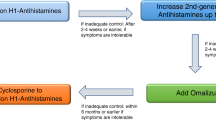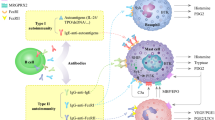Abstract
Purpose of Review
Chronic urticaria is a common dermatological condition that has significant impact on quality of life. Multiple international societies have published guidelines, and although these guidelines generally agree on the definition of urticaria, as well as approach to diagnosis and management, there have been notable differences to date. These differences have been reconciled by the recent publication of the 2017 revision and update published by the EAACI/GA2LEN/EDF/WAO.
Recent Findings
The 2017 revision and update to the guidelines for chronic urticaria are the most comprehensive consensus document to date, and reconcile previously existing differences between the US, European, and Asian guidelines.
Summary
The purpose of our review is to present basic background on urticaria and discuss classification, diagnosis, and most importantly, management. We present differences from previous US, European, and Asian guidelines and reconcile the previous differences by summarizing the 2017 revision and update published by the EAACI/GA2LEN/EDF/WAO.

Similar content being viewed by others
References
Papers of Particular Interest, Published Recently, Have Been Highlighted as: • of Importance •• of Major Importance
Kaplan A. Clinical practice: chronic urticaria and angioedema. NEJM. 2002;64:1427–43.
Zuberbier T, Aberer W, Asero R, Bindslev-Jensen C, Brzoza Z, Canonica GW, et al. Methods report on the development of the 2013 revision and update of the EAACI/GA2 LEN/EDF/WAO guideline for the definition, classification, diagnosis, and management of urticaria. Allergy. 2014;69(7):e1–29.
Greaves M. Chronic urticaria. J Allergy Clin Immunol. 2000;105:664–72.
Zuberbier T, Balke M, Worm M, Edenharter G, Maurer M. Epidemiology of urticaria: a representative cross-sectional population survey. Clin Exp Dematol. 2010;35:869–73.
Toubi E, Kessel A, Avshovich N, Bamberger E, Sabo E, Nusem D, et al. Clinical and laboratory parameters in predicting chronic urticaria duration: a prospective study of 139 patients. Allergy. 2004;59(8):869–73.
Amin P, Levin L, Holmes SJ, Picard J, Bernstein JA. Investigation of patient-specific characteristics associated with treatment outcomes for chronic urticaria. J Allergy Clin Immunol Pract. 2015;3(3):400–7.
Poulos LM, Waters AM, Pop Htlh GD, Correll PK, Loblay RH, Marks GB. Trends in hospitalizations for anaphylaxis, angioedema, and urticaria in Australia, 1993-1994 to 2004-2005. J Allergy Clin Immunol. 2007;120:878–84.
O’ Donnell BF, Lawlor F, Simpson J, Morgan M, Greaves MW. The impact of chronic urticaria on quality of life. Brit J of Dermatol. 1997;136(2):197–201.
• Bernstein JA, Lang DM, Khan DA, Craig T, Dreyfus D, Hsieh F, et al. The diagnosis and management of acute and chronic urticaria: 2014 update. J allergy Clin Immunol. 2014;133:1270–7. Practice parameters outlining the 2014 US guidelines on the diagnosis and management of chronic urticaria
• Zuberbier T, Asero R, Bindslev-Jensen C, Brzoza Z, Canonica GW, Church MK. The EAACI/GA2LEN/EDF/WAO guideline for the definition, classification, diagnosis, and management of urticaria: the 2013 revision and update. Allergy 2014: 69: 868-87. Document outlining the 2013 European guidelines on the diagnosis and management of chronic urticaria.
•• Zuberbier T, Aberer W, Asero R, Abdul Latiff AH, Baker D, Ballmer-Weber B, et al. The EAACI/GA2LEN/EDF/WAO guideline for the definition, classification, diagnosis, and management of urticaria: the 2017 revision and update. Allergy 2018: Epub ahead of print. 2017 revision and update to urticaria guidelines, the most comprehensive consensus document to date.
• Chow SK. Management of chronic urticaria in Asia: 2010 AADV consensus guidelines. Asia Pac Allergy. 2012;2:149–60. Document outlining the 2010 Asian guidelines on the diagnosis and management of chronic urticaria
Hide M, Hiragun T. Japanese guidelines for diagnosis and treatment of urticaria in comparison with other countries. Allergol Int. 2012;61:517–27.
Mlynek A, Zalewska-Janowska A, Martus P, Staubach P, Zuberbier T, Maurer M. How to assess disease activity in patients with chronic urticaria. Allergy. 2008;63:777–80.
Weller KG, Magerl M, Tohme M, Martus N, Krause P, Metz K, et al. Development, validation, and initial results of the angioedema activity score. Allergy. 2013;68(9):1185–92.
Weller K, Groffik A, Church MK, Hawro T, Krause K, Metz M, et al. Development and validation of the urticaria control test: a patient-reported outcome instrument for assessing urticaria control. J Allergy Clin Immunol. 2014;133(5):1365–72.
Ohanyan T, Schoepke N, Bolukbasi B, Metz M, Hawro T, Zuberbier T, et al. Responsiveness and minimal important difference of the urticaria control test. J Allergy Clin Immunol. 2017;140(6):1710–3.
Kowalski ML, Woessner K, Sanak M. Approaches to the diagnosis and management of patients with a history of nonsteroidal anti-inflammatory drug-related urticaria and angioedema. J Allergy and Clin Immunol. 2015;136(2):245–51.
Tarbox JA, Gutta RC, Radojicic C, Lang DM. Utility of routine laboratory testing in management of chronic urticaria/angioedema. Ann Allergy Asthma Immunol. 2011;107:239–43.
Magerl M, Pisurevokaja D, Scheufele R, Zuberbier T, Manner M. Effects pf pseudoallergen diet on chronic spontaneous urticaria: a prospective trial. Allergy. 2010;65:78–83.
Maurer M, Keller W, Bindslev-Jensen C, Gimenez-Arnau A, Bousquet PJ, Bousquet J, et al. Unmet clinical needs in chronic spontaneous urticaria. A Galen task force report. Allergy. 2010;66:317–30.
• Sanchez-Borges M, Asero R, Ansotegui IJ, Baiardino I, Bernstein JA, Canonica GW, et al. Diagnosis and treatment of urticaria and angioedema: a worldwide perspective. WAO Journal. 2012;5:125–47. Document outlining the 2012 global guidelines on the diagnosis and management of chronic urticaria
Handa S, Dogra S, Kumar B. Comparative efficacy of cetirizine and fexofenadine in the treatment of chronic idiopathic urticaria. J Dermatolog Treat. 2004;15:55–7.
Potter PC, Kapp A, Maurer M, Guillet G, Jian AM, Hauptmann P, et al. Comparison of the efficacy of levocetirizine 5 mg and desloratadine 5 mg in chronic idiopathic urticaria patients. Allergy. 2009;64:596–604.
Zuberbier T, Oanta A, Bogacka E, Medina I, Wesel F, Uhl P, et al. Comparison of the efficacy and safety of bilastine 20 mg versus levocetirizine 5 mg for the treatment of chronic idiopathic urticaria: a multi-Centre, double-blind, randomized, placebo-controlled study. Allergy. 2010;65:516–28.
Grant JA, Riethuisen JM, Moulaert B, DeVos C. A double-blind, randomized, single-dose, crossover comparison of levocetirizine with ebastine, fexofenadine, loratadine, mizolastine, and placebo: suppression of histamine-induced wheal-and-flare response during 24 hours in healthy male subjects. Ann Allergy Asthma Immunol. 2002;88:190–7.
Staevska M, Popov TA, Kralimarkova T, Lazarova C, Kraeva S, Popova D. The effectiveness of levocetirizine and desloratadine in up to 4 times conventional doses in difficult-to-treat urticaria. J Allergy Clin Immunol. 2010;125:676–82.
Asero R. Chronic unremitting urticaria: is the use of antihistamine above licensed dose effective? A preliminary study of cetirizine at licensed and above-licensed doses. Clin Exp Dermatol. 2007;32:34–8.
Monroe EW. Relative efficacy and safety of loratadine, hydroxyzine, and placebo in chronic idiopathic urticaria. Clin Ther. 1992;14:17–21.
Schweitzer PK, Muehlbach MJ, Walsh JK. Sleepiness and performance during three-day administration of cetirizine or diphenhydramine. J Allergy Clin Immunol. 1994;94:716–24.
Nettis E, Dambra P, D’Oronzio L, Loria MP, Ferrannino A, Tursi A. Comparison of montelukast and fexofenadine for chronic idiopathic urticaria. Arch Dermatol. 2001;137:99–100.
Bagenstose SE, Levin L, Bernstein JA. The addition of zafirlukast to cetirizine improves the treatment of chronic urticaria in patients with positive autologous serum skin test results. J Allergy Clin Immunol. 2004;113:134–40.
Nettis E, Colanardi MC, Paradiso MT, Ferrannini A. Desloratadine in combination with montelukast in the treatment of chronic urticaria: a randomized, double-blind, placebo-controlled study. Clin Exp Allergy. 2004;34:1401–7.
Sanada S, Tanaka T, Kameyoshi Y, Hide M. The effectiveness of montelukast for the treatment of anti-histamine-resistant chronic urticaria. Arch Dermtol Res. 2005;297:134–8.
DiLorenzo G, D’Alcamo A, Rizzo M, Leto-Barone MS, Bianco CL, DItta V, et al. Leukotriene receptor antagonists in monotherapy or in combination with antihistamines in the treatment of chronic urticaria: a systemic review. J Asthma Allergy. 2008;9:9–16.
Harvey PR, Wegs J, Shocket AL. A controlled trial of therapy in chronic urticaria. J Allergy Clin Immunol. 1981;68:262–6.
Monroe EW, Cohen SH, Kalbfleisch J, Schulz CI. Combined H1 and H2 antihistamine therapy in chronic urticaria. Arch Dermatol. 1981;117:404–7.
Bleehan SS, Thomas SE, Greaves MW, Newton J, Kennedy CT, Hindley F, et al. Cimetidine and chlorpheniramine in the treatment of chronic idiopathic urticaria: a multi-Centre randomized double-blind study. Br J Dermatol. 1987;117:81–8.
Paul E, Bodeker RH. Treatment of chronic urticaria with terfenadine and ranitidine. A randomized, double-blind study in 45 patients. Eur J Clin Phamacol. 1986;31:277–80.
Sharpe GR, Shuster R. In dermographic urticaria H2 receptor antagonists have a small but therapeutically irrelevant additional effect compared to H1 antagonists alone. Br J Dermatol. 1993;129:575–9.
Salo OP, Kauppinen K, Mannisto PT. Cimetidine increases the plasma concentration of hydroxyzine. Acta Derm Venereol. 1986;66:349–50.
Simons FE, Sussman GL, Simons KJ. Effect of the H2-antagonist cimetidine on the pharmacokinetics and pharmacodynamics of the H2 antagonists hydroxyzine and cetirizine in patients with chronic urticaria. J Allergy Clin Immunol. 1995;95:685–93.
• Khan DA. Alternative agents in refractory chronic urticaria: evidence and considerations on the selection and use. J Allergy Clin Immunol Prac. 2013;1:433–40. Review of alternative agents used in the management of refractory cases of chronic urticaria
Saini S, Rosen KE, Hsieh HJ, Wong DA, Conner E, Kaplan A, et al. A randomized, placebo-controlled, dose-ranging study of single-dose omalizumab in patients with H-1-antihistamine-refractory chronic idiopathic urticaria. J Allergy Clin Immunol. 2011;128(3):567–U195.
•• Maurer M, Rosen K, Hsieh HJ, Saini S, Grattan C, Gimenez-Arnau A, et al. Omalizumab for the treatment of chronic idiopathic or spontaneous urticaria. N Engl J Med. 2013;368(10):924–35. Landmark study demonstrating the efficacy of omalizumab in chronic urticaria
Zhao ZT, Ji CM, Yu WJ, Meng L, Hawro T, Wei JF, et al. Omalizumab for the treatment of chronic spontaneous urticaria: a meta-analysis of randomized clinical trials. J Allergy Clin Immunol. 2016;137(6):1742–50.
Grattan CE, O'Donnell BF, Francis DM, Niimi N, Barlow RJ, Seed PT, et al. Randomized double-blind study of cyclosporin in chronic 'idiopathic' urticaria. Br J Dermatol. 2000;143(2):365–72.
Vena GA, Cassano N, Colombo D, Peruzzi E, Pigatto P. Cyclosporine in chronic idiopathic urticaria: a double-blind, randomized, placebo-controlled trial. J Am Acad Dermatol. 2006;55(4):705–9.
• Kulthanan K, Chaweekulrat P, Komoltri C, Hunnangkul S, Tuchinda P, Chularojanamontri L, et al. Cyclosporine for chronic spontaneous urticaria: a meta-analysis and systematic review. J Allergy Clin Immunol Pract. 2018;6(2):586–99. Meta-analysis reviewing the literature for cyclosporine in refractory cases of chronic urticaria
Yang K. Placental 11 beta-hydroxysteroid dehydrogenase: barrier to maternal glucocorticoids. Rev Reprod. 1997;2:129–32.
Ost L, Wettrell G, Bjorkman I, Rane A. Prednisolone excretion in human milk. J Pediatr. 1985;106:1008–11.
Author information
Authors and Affiliations
Corresponding author
Ethics declarations
Conflict of Interest
S. Shahzad Mustafa declared that he is on the speaker's bureau for Genentech.
Mario Sánchez-Borges declared that no conflicts of interest relevant to this manuscript.
Human and Animal Rights and Informed Consent
This article does not contain any studies with human or animal subjects performed by any of the authors.
Additional information
This article is part of the Topical Collection on Allergic Skin Diseases
Rights and permissions
About this article
Cite this article
Shahzad Mustafa, S., Sánchez-Borges, M. Chronic Urticaria: Comparisons of US, European, and Asian Guidelines. Curr Allergy Asthma Rep 18, 36 (2018). https://doi.org/10.1007/s11882-018-0789-3
Published:
DOI: https://doi.org/10.1007/s11882-018-0789-3




